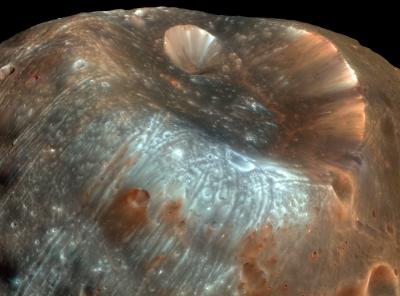
The Russian mission will be the space agency's second attempt to return a sample from Phobos. Head was a participating scientist on the first try, which launched in 2011, but an engine failure felled the spacecraft before it could leave Earth orbit. The next attempt is scheduled to launch in 2020 or shortly thereafter.
This new research grew out of preparation for the original mission, which would still be en route to Phobos had it not encountered problems. Scientists had long assumed Phobos likely contained Martian bits, but Russian mission planners wanted to know just how much might be there and where it might be found. They turned to Head and Ken Ramsley, a visiting researcher in Brown's planetary geosciences group.
To answer those questions, Ramsley and Head started with a model based on our own Moon to estimate how much of Phobos' regolith (loose rock and dust on the surface) would come from projectiles. They then used gravitational and orbital data to determine what proportion of that projectile material came from Mars.
"When an impactor hits Mars, only a certain of proportion of ejecta will have enough velocity to reach the altitude of Phobos, and Phobos' orbital path intersects only a certain proportion of that," Ramsley said. "So we can crunch those numbers and find out what proportion of material on the surface of Phobos comes from Mars."
For a little more insight into the project see this:
http://www.eurekalert.org/pub_releases/2013-11/bu-mtm111113.php
